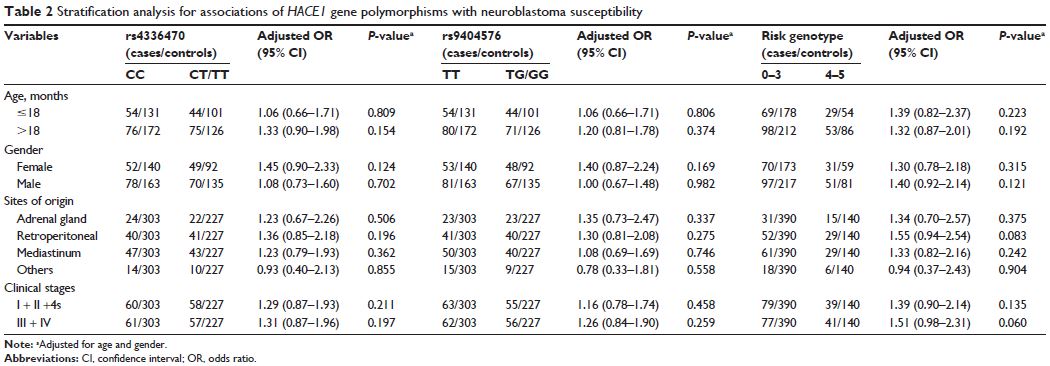100205
论文已发表
注册即可获取德孚的最新动态
IF 收录期刊
- 3.3 Breast Cancer (Dove Med Press)
- 3.4 Clin Epidemiol
- 2.5 Cancer Manag Res
- 2.9 Infect Drug Resist
- 3.5 Clin Interv Aging
- 4.7 Drug Des Dev Ther
- 2.7 Int J Chronic Obstr
- 6.6 Int J Nanomed
- 2.5 Int J Women's Health
- 2.5 Neuropsych Dis Treat
- 2.7 OncoTargets Ther
- 2.0 Patient Prefer Adher
- 2.3 Ther Clin Risk Manag
- 2.5 J Pain Res
- 2.8 Diabet Metab Synd Ob
- 2.8 Psychol Res Behav Ma
- 3.0 Nat Sci Sleep
- 1.8 Pharmgenomics Pers Med
- 2.7 Risk Manag Healthc Policy
- 4.2 J Inflamm Res
- 2.1 Int J Gen Med
- 4.2 J Hepatocell Carcinoma
- 3.7 J Asthma Allergy
- 1.9 Clin Cosmet Investig Dermatol
- 2.7 J Multidiscip Healthc

HACE1 基因和神经母细胞瘤易感性在中国南方人群中的常见变化
Authors Zhang Z, Zhang R, Zhu J, Wang F, Yang T, Zou Y, He J, Xia H
Received 30 November 2016
Accepted for publication 7 January 2017
Published 8 February 2017 Volume 2017:10 Pages 703—709
DOI https://doi.org/10.2147/OTT.S129042
Checked for plagiarism Yes
Review by Single-blind
Peer reviewers approved by Dr Lucy Goodman
Peer reviewer comments 2
Editor who approved publication: Dr Samir Farghaly
Abstract: Neuroblastoma is a common fatal pediatric cancer of the developing
sympathetic nervous system, which accounts for ~10% of all pediatric cancer
deaths. To investigate genetic risk factors related to neuroblastoma, many
genome-wide association studies have been performed, and single nucleotide
polymorphisms (SNPs) within HACE1 gene have been identified to associate
with neuroblastoma risk. However, the association of the HACE1 SNPs with neuroblastoma needs to be
validated in Southern Chinese children. We genotyped five SNPs located in the HACE1 gene (rs4336470 C>T, rs9404576
T>G, rs4079063 A>G, rs2499663 T>C, and rs2499667 A>G) in 256
Southern Chinese patients in comparison with 531 ethnically matched healthy
controls. Single locus analysis showed no significant association between any
of HACE1 SNPs and
neuroblastoma risk in Southern Chinese children. However, when all the risk
genotypes were combined, we found a borderline significant trend toward an
increased neuroblastoma risk with 4–5 risk genotypes (adjusted odds ratio
=1.36, 95% confidence interval =0.98–1.89, P =0.065). Moreover,
stratified analysis found that carriers of 4–5 risk genotypes tended to
develop neuroblastoma in the retroperitoneal region and have more aggressive
tumors, progressing to advanced clinical stages III/IV, when compared with
those of 0–3 risk genotypes. In conclusion, HACE1 gene may have weak effect on
neuroblastoma risk in Southern Chinese children. Large well-designed studies
are needed to strengthen our findings.
Keywords: HACE1 ,
susceptibility, neuroblastoma, GWAS, polymorphism
